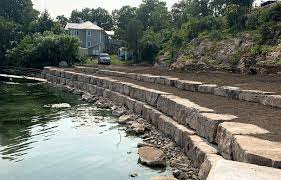Waterfront properties boast stunning views and unique landscapes, but they often present challenges such as soil erosion and instability. A well-designed retaining wall can be a vital solution, not only addressing these challenges but also enhancing the aesthetics of your waterfront property. In this article, we’ll explore the importance of retaining walls for waterfront properties, the key considerations in their design, and the benefits they bring to both function and form.
Erosion Control:
Waterfront locations are susceptible to erosion due to the constant action of waves and water currents. A retaining wall acts as a protective barrier, preventing soil from being washed away and stabilizing the shoreline. This not only preserves the integrity of your property but also safeguards the natural beauty of the waterfront.
Slope Stabilization:
Many waterfront properties feature slopes leading down to the water. A retaining wall helps stabilize these slopes, reducing the risk of landslides or soil slippage. By creating a structured support system, the retaining wall ensures that the soil remains in place, preserving the safety and longevity of your waterfront landscape.
Enhanced Property Utilization:
Retaining walls allow for effective land utilization on waterfront properties. By creating terraced levels, these walls provide flat surfaces for various purposes such as gardening, seating areas, or recreational spaces. This enhances the functionality of your property, transforming steep and unusable slopes into practical and enjoyable areas.
Customized Design Aesthetics:
Retaining walls are not merely functional; they also contribute to the visual appeal of your waterfront property. The design of the retaining wall can be customized to complement the overall aesthetic of your home and landscape. Using materials like natural stone, brick, or timber allows you to create a retaining wall that seamlessly blends with the natural surroundings.
Elevation and View Optimization:
A strategically designed retaining wall can optimize the elevation of your waterfront property, offering better views of the water. By creating tiered levels, each with a distinct purpose, you can enjoy unobstructed panoramas from different vantage points. This elevation optimization adds value to your property by maximizing its scenic potential.
Drainage Management:
Retaining walls play a crucial role in managing water drainage on waterfront properties. They help control the flow of rainwater, preventing soil erosion and waterlogged areas. Proper drainage design in conjunction with the retaining wall ensures a balanced and sustainable solution for managing water runoff on your property.
Long-Term Stability:
Investing in a well-constructed retaining wall ensures the long-term stability of your waterfront property. Quality materials and professional construction methods contribute to the durability and resilience of the wall, providing peace of mind for homeowners. Proper maintenance further ensures the wall’s effectiveness in preserving the integrity of the shoreline.
Ecological Preservation:
Retaining walls can contribute to ecological preservation by preventing soil erosion and protecting the natural habitat surrounding your waterfront property. The stabilization of slopes and shorelines helps maintain the balance of local ecosystems, preserving flora and fauna that contribute to the overall biodiversity of the area.
Regulatory Compliance:
Many waterfront properties are subject to environmental regulations and zoning restrictions. A professionally designed and constructed retaining wall ensures compliance with these regulations, avoiding potential legal issues and fines. Working with experts who understand local requirements is essential to creating a retaining wall that meets both aesthetic and regulatory standards.
Increased Property Value:
Beyond the functional and aesthetic benefits, a well-designed retaining wall can significantly increase the value of your waterfront property. Potential buyers are likely to view a professionally constructed and visually appealing retaining wall as an asset, recognizing the investment in both form and function.
Conclusion:
A retaining wall is a multifaceted solution for addressing the unique challenges posed by waterfront properties. From erosion control and slope stabilization to enhanced property utilization and aesthetic appeal, these walls offer a comprehensive set of benefits. When carefully designed and constructed, a retaining wall becomes a seamless and integral part of your waterfront landscape, contributing to the long-term stability and beauty of your property.

